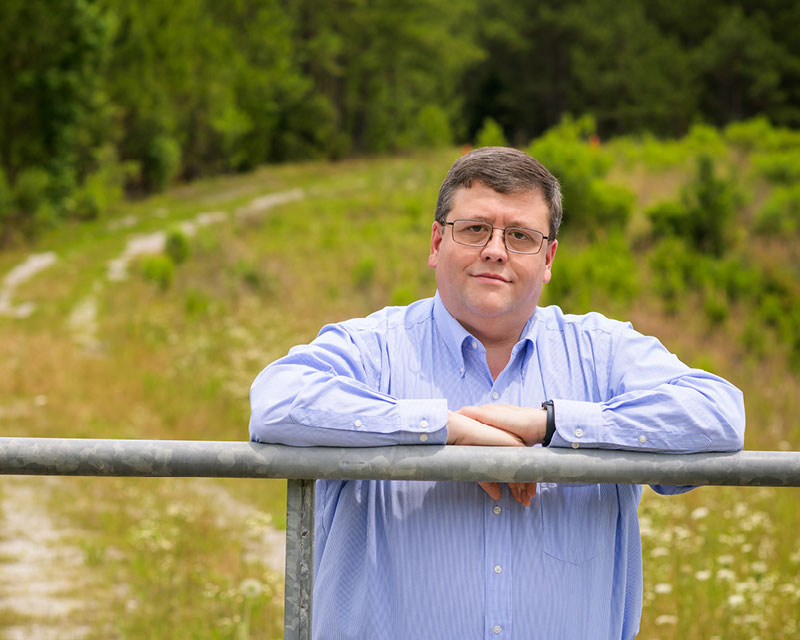Growing up in Eutaw, Alabama, (pop. 2,803), Drake Lavender, M.D., suffered from asthma and severe allergies. His lifeline was his family doctor, Rucker Staggers, M.D., who treated him weekly with allergy shots, and the two developed a strong patient-doctor bond.
“He became a mentor for me,” Lavender said. “I didn’t know I wanted to be a family medicine physician but I knew I wanted to be like Dr. Staggers. I wanted to have that kind of impact on someone’s life.”
Today, as director of Rural Programs at the University of Alabama (UA) College of Community Health Sciences (CCHS), Lavender is acutely aware of what he didn’t know as a kid—that primary care physicians like Staggers are increasingly rare in small towns like Eutaw.

According to the Alabama Office of Healthcare Workforce (AOHW), 52 rural population centers in the state have a shortage of primary care physicians. The repercussions for these medically underserved communities are dire. A 2021 National Center for Health Statistics (NCHS) brief stated that from 1999 to 2019, differences between rural and urban areas in death rates for conditions like heart disease, cancer, and chronic lower respiratory disease widened. In 2019, the age-adjusted death rate in rural areas was 20 percent higher than in urban areas.
The University of Alabama System launched Rural Programs in the 1990s in response to these alarming statistics. It’s an umbrella program designed to recruit potential medical students from rural Alabama in hopes they will go back to serve these communities where they are desperately needed.
Lavender himself became one of these students in 1996 when he joined the first cohort of Rural Medical Scholars, a subset of Rural Programs that represents a joint effort between the Heersink School of Medicine and CCHS. Rural Medical Scholars recruits college students who want to attend medical school and, it is hoped, practice in rural Alabama counties. After graduating from medical school at UAB, with his clinical years spent in Tuscaloosa, he completed his residency and served as chief resident at The University of Alabama Family Medicine Residency. Lavender then began practicing primary care in Gordo, Alabama (population 1,584).
In Gordo, Lavender realized how much he liked practicing in a rural setting. “I enjoyed the life of a small town and the closeness you can have with your patients,” he said. “They aren’t just your patients in the office. They are your friends at the grocery store, at church, at football games. I grew up in that kind of community and it appealed to me.”
In 2014, he decided to return to UA and later took over as director of Rural Programs. “It’s come full circle for me to return to the program that gave me my chance,” he said. “I can help other people get a chance, too.”
Lavender said recruiting rural students into medicine requires changing established norms. “While the data tells us the people most likely to practice in rural areas are those who come from rural communities,” he said, “our country’s medical education system has mostly failed at recruiting and admitting people from rural areas.” Lavender points to a study by Scott Shipman, M.D., MPH, the director of primary care initiatives and clinical innovations at the Association of American Medical Colleges (AAMC), finding that students from rural backgrounds made up just 4.3 percent of the country’s incoming medical student body. “That’s a big problem if you’re trying to get people to practice in rural areas. You really need physicians who understand rural culture and are comfortable living and practicing in those communities.”
Rural Programs includes several pathways for students to become exposed to and enter the medical and health care fields. Rural Medical Scholars—the program through which Lavender came—is just one. Others include Rural Health Scholars, in which high-school students spend part of a summer on the UA campus, take classes, and learn about careers in medicine. Another program, the Tuscaloosa Rural Premedical Internship, invites undergraduates to shadow local preceptors in Tuscaloosa and small towns around the state. Minority Rural Health Scholars targets high school graduates from communities traditionally underrepresented in medicine. And this past year saw the launch of Rural Dental Scholars, affiliated with the UAB School of Dentistry.
Lavender spoke about Rural Programs at the 2023 Medical Alumni Weekend and was encouraged by the reception. “A lot of medical alumni members were very interested in what we’re doing and how we can continue to work on this issue,” he said. “The focus on primary care and rural health needs to be at the forefront in all of our medical schools.”
Just as the problem has been growing over time, Lavender adds, it will take continued effort to reverse it. “As of this year, we have 58 full-time, primary care physicians in rural Alabama who’ve come through the Rural Medical Scholars Program,” he said. “In addition to all their great work as doctors, we ask them to help us find the next generation. They have a wonderful platform to help us identify students in their communities to send back to our program and start the cycle over again.”
-Rosalind Fournier